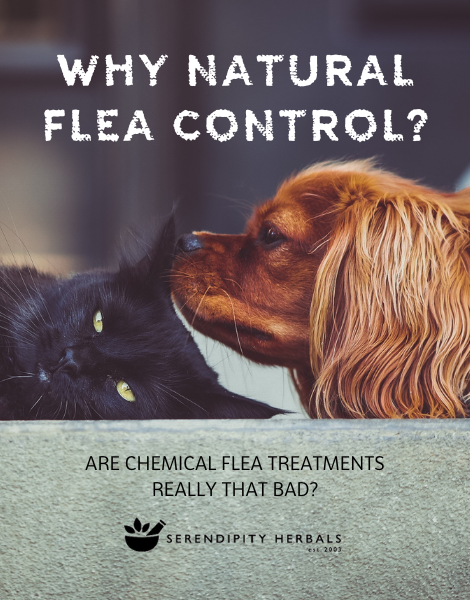Why Natural Flea Control?
12 June 2023

Fleas and ticks are not just pests, they can be dangerous too – and so can their treatments.
But is there another, natural way?
Yes, certainly! We’ve found it.
For dog and cat owners, fleas and ticks can be a constant source of stress in the summer months. The most common answer is to start your pet on a course of pharmaceutical pesticide to prevent them from getting fleas. But what don’t we know about these popular pet flea treatments? Well, quite a lot, as it turns out...
Ticks and fleas spread diseases
It’s well known now that fleas were the problem behind the bubonic plague. While Yersinia pestis can now be treated with antibiotics, fleas can also spread diseases like cat scratch fever and tapeworm, and can trigger allergic reactions.
Your pet must be protected against them – that much is clear. It might be tempting to go for a pharmaceutical option, especially if you haven’t come across natural flea control.
The problem with pharmaceuticals
You've probably heard of – maybe have even used – a popular flea and tick solution like Advantix, Advocate, and Advantage to protect your pet from fleas. They all contain a pesticide called imidacloprid. Imidacloprid and other chemicals like nitenpyram and dinotefuran all belong to a family called neo-nicotinoids.
Though neo-nicotinoids are banned from agricultural practices, as they kill bees, pollute waterways, and damage the environment – they're still used in pet products as spot-on treatments for fleas and ticks. That’s why you shouldn’t bathe your pet when you treat it with Advantix. It was assumed that there would be no risk to pets or the environment, however, studies have now shown that this is not the case.
Recent research (2023) from the Imperial College London have found that toxic flea and tick preventives are finding their way into UK freshwater in concentrations that are toxic to freshwater wildlife.
Dr Andrew Prentis, a visiting fellow of the College and a member of Vet Sustain, said that not only are the benefits of these pesticides on humans and animals not well evidenced, but that as well as pollutants they are also increasing the risk of fleas and ticks becoming resistant, due to overuse.
Furthermore, two common ingredients in chemical flea and tick products, permethrin and pyrethrins, are very toxic to cats. Don’t put these ingredients on your dog, either, if you also have a cat that could snuggle up with or brush against it.
There is emerging evidence to suggest that some treatments are linked to seizures in pets – and the active ingredient fluralaner in Br***cto is associated with other effects such as tremors and neurological problems like wobbliness or ataxia.
A gentler approach is needed, and there is another way – one that doesn’t harm wildlife, because it’s straight from nature itself.
The benefits of Neem
Neem is a tree from India with natural pesticidal properties. It repels biting insects such as fleas, ticks, and mites, and acts as an anti-feeding and mobility disruptor and inhibits the feeding insect’s development: in other words, it stops fleas eating, stops them laying eggs, stops them moving about and stops them breeding, while remaining non-toxic to pollinators and earthworms.
Neem is used a lot as a natural approach to controlling aphids in the garden – and it can be used for pets too! It is often used as a natural pesticide alternative to conventional, and often toxic, chemical mixes.
Unlike chemical treatments, Neem needs to be applied regularly as it biodegrades about 5-7 days after it has been exposed to the elements. With that in mind, it can never build up to toxic levels, and studies have shown that the oil can be used regularly and in low doses.
The benefits of neem don’t end there! It relieves the redness and itchiness of irritated skin on dogs, humans, chickens, horses and other animals, among many other benefits. Even allergic or sensitive pets can benefit!
Neem is also non-toxic to animals – both dogs and cats can benefit from natural flea control: this is simply what we call a non-toxic, holistic, and environmentally friendly approach to flea control, using our knowledge of the pest’s own biology and safe, gentle ingredients straight from nature against fleas and ticks.
With resistance emerging to common insecticides like the pyrethrin, it’s time that neem became more widely used as a chemical-free anti-flea and tick treatment: it has existed for thousands of years!
- According to recent research, chemical pet flea and tick treatments are toxic to the environment and to some pets, and encouraging resistance in fleas, becoming less effective over time.
- Many people now want to take a more natural approach to flea and tick treatment.
- Neem is an anti-biting insect solution straight from nature, with soothing and anti-viral qualities.
- Neem is safe for pets and people and above all the environment!
References:
Azeem, S., Akbar, H., Ahmad, L., Ashraf, M., & Puvanendiran, S. (2023). When used in animals, a neem (Azadirachta indica)-based ectoparasiticide performs better than a synthetic one. Journal of the Hellenic Veterinary Medical Society, 73(4), 4833–4840. https://doi.org/10.12681/jhvms.27963
Gaens, D., Rummel, C., Schmidt, M. 'Suspected neurological toxicity after oral application of fluralaner (Bra vecto®) in a Kooikerhondje dog. BMC Vet Res, 283 (2019). https://doi.org/10.1186/s12917-019-2016-
Preston-Allen, R.G.G., Albini, D., Barron, L., Collins, T., Dumbrell, A., Duncalf-Youngson, H., Jackson, M., Johnson, A., Perkins, R., Prentis, A., Spurgeon, D., Stasik, N., Wells, C. and Woodward, G. (2023).'Are urban areas hotspots for pollution from pet parasiticides?' Grantham Institute Briefing note #15
Fact Sheet for Pet Owners and Veterinarians about Potential Adverse Events Associated with Isoxazoline Flea and Tick Products | FDA
Come follow us on social media for all the latest news and updates.